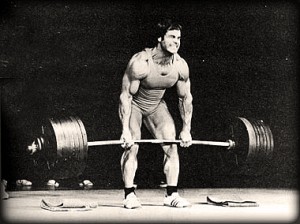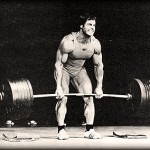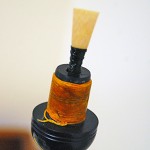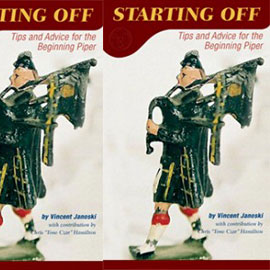Be a Stronger Bagpiper III: Literally
 Here’s a story familiar to many.
Here’s a story familiar to many.
You show up at band rehearsal and the Pipe Major is doling out new chanter reeds. Oh boy! You get yours and pop it in but then the practice session continues for a while and it is finally, mercifully over and you’re drenched in sweat, your sides hurt, and your abdominal muscles feel like they’re ready to snap. Did you actually eek out any music during this time? Is this normal? Maybe. Many factors play into this scenario. We make excuses like “the reed is new, it’ll lighten up,” or “I need to check my bag for leaks,” or something to that effect. But a major factor that contributes to this experience is summed up in two words: Physical fitness.
Is there an instrument that is more physically taxing than Highland bagpipes? It’s part of the charm, for sure. Good tonal production on the bagpipe requires no small amount of physical stamina and exertion. Being a stronger bagpiper is not just about stronger fingers and better quality playing, it is about being a stronger bagpiper, literally.
Solutions to the scenario described above can only take one of two paths, all other things being equal: 1. You can get an easier reed and thus make the experience of playing less of a chore; or 2. You can be physically stronger and thus make the experience of playing less of a chore. There are many projects here at Pipehacker that get you hacking the mechanics of your instrument, but now it’s time to hack the mechanics of your body.
Yes, yes, I know, no one wants to talk about exercise and working out. You’re thinking, “What’s that got to do with piping? I want to hear how to play better D throws and how to express my strathspeys!” Physical exercise is not something that is often talked about (at all) when learning the bagpipes. We talk a lot about practice routines and finger workouts, quality of tone and music, but what about physical conditioning? How many pipers are barely able to get through an MSR or long piobaireachd—musically—because physically playing the instrument is a struggle? It’s distracting to work like that and we have a lot to think about when we’re trying to produce good music. Sure, the physical part of playing is going to have a lot to do with the air efficiency of your instrument, the relative strength of your reeds, and the quality of your bagpipe set up. But physical strength and conditioning play as big a part.
You’ll notice that many of the best bagpipers on the planet are fairly big guys. That’s no accident. The bigger you are the more weight you have to throw behind your movement, and the greater strength you are likely to have over someone of smaller stature. That additional strength plays a big part in your ability to produce a quality sound on the instrument with ease and thus, make it super easy to focus more on the music.
Those of us not blessed with that kind of natural power can certainly build it. That’s what exercise is all about. That’s why P90X and Insanity and all those other high-intensity interval training programs (HIIT) are so popular. We all realize that physical fitness is important to our overall well being.
I have always struggled with consistent strong blowing on the bagpipe. (Seriously, who hasn’t?) But through all the workouts and practice regimens I’ve used to make that better, there was still a missing element to keep things improving at a satisfactory pace. So I enrolled in a local cross-fit, HIIT class in January and I now realize what element was missing. I was in piss-poor shape. I am in general good health but, man o man. I can now say, however, almost four months later, that I feel fantastic and have noticed an order of magnitude difference when I play bagpipes. What’s changed? I would say that the most important change has been in the way I breathe. Those intense workouts forced me to breathe deeper and with more rhythm and urgency than any amount of piping will do. Besides just feeling good and having better core strength, it is the single thing I think that is behind an enhanced ability to produce consistent quality tone on the bagpipe. This workout class has been the best money spent on piping in a while. A worthy investment, I say.
Like building the quality of your crunluaths, physical fitness is about starting simply and slowly and then increasing intensity as you go, not expecting large transformations in the beginning, and having the confidence that the work is going to pay off.
Here is a 30 minute workout anyone can do in their living room at zero cost. It is similar to many of the longer cross-fit type workouts you see and is designed to work the core. I’ll rename it the “Piper’s Power Workout.” Start here and have faith!
Piper’s Power Workout
1. Warm up for five to eight minutes. Do whatever you like to get your heart rate up. Jumping jacks, jog in place, or a combination of different things. Then do each of the following, one right after the other.

2. Jungle squats (1 minute)
3. Push ups (1 minute)

4. Reverse V lunges (1 minute)

5. Chair dips (1 minute)

6. Cardio (2 minutes; see no. 1 above)

7. Abdominal crunches, sit-ups, or leg lifts (1 minute)

8. Take a 30 second break.
Repeat steps 2 through 8. Repeat again. Done.
You can google these exercises for full descriptions on how to do them properly. A quick Google search will bring up videos showing these exercises or, you can get a breakdown of the step-by-step here.
Is it hard to motivate yourself for formal exercise? You bet. But would you be more motivated if you knew that exercise would improve your playing and make you a better bagpiper? It is without a doubt that better physical fitness and conditioning will contribute to your ability to produce better tone on your instrument and allow you to hold fatigue at bay and play better music.
Oh, and being a stronger bagpiper also means good nutrition. So, as a bonus, here is a vitamin- and protein-packed, all-natural smoothie that is sure to keep your energy up. Everything you need is in it. Drink this every day and, along with the workout above, that new gut-buster chanter reed will beg for mercy. You’re welcome.
PIPER’S POWER SMOOTHIE
Makes enough for your favorite Imperial pint glass.
1/2 cup orange juice
1/2 cup buckwheat groats

1/2-3/4 cup 2% Fage greek yogurt (or any low-fat Greek yogurt, make sure it’s Greek and not Greek-style)
1/2-whole banana (depending on how thick you want it)
2 tbsp molasses

2-3 cups baby spinach leaves
1/2 cups frozen blueberries or a few frozen blackberries (I like the blackberries better.)

3 ice cubes or 1 cup crushed ice
Soak a bunch of the buckwheat in orange juice or water in the fridge overnight to soften. Put all ingredients in a blender and blend well for about 2 minutes. Drink immediately.
-
Michael F Bell
-
pipervin
-
 Pipehacker
Pipehacker








